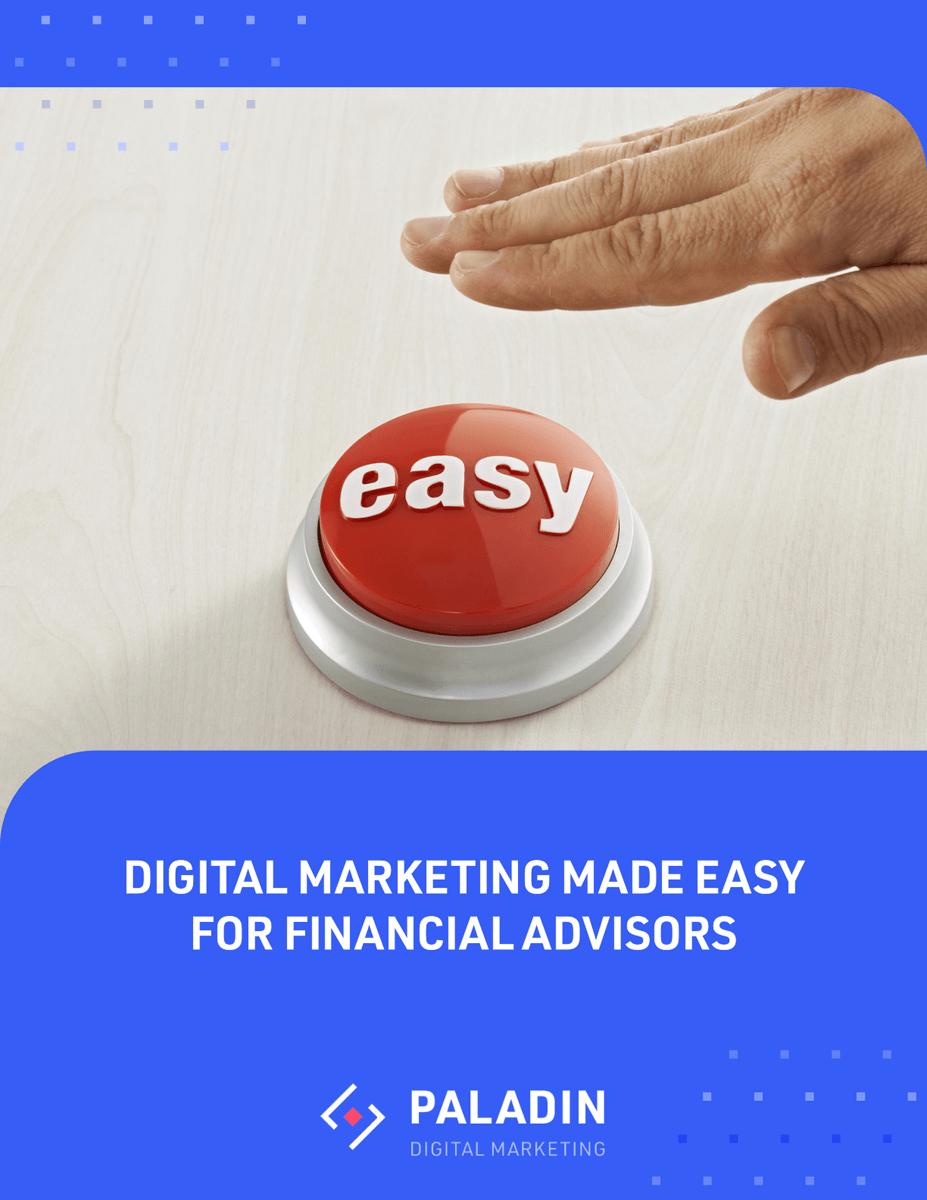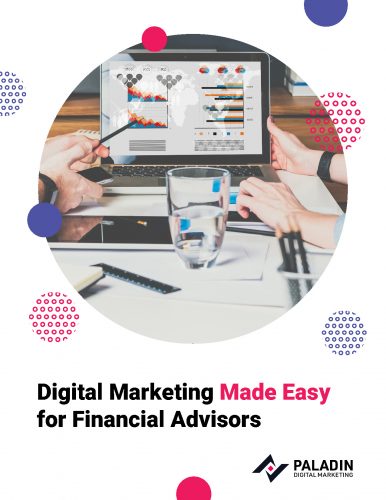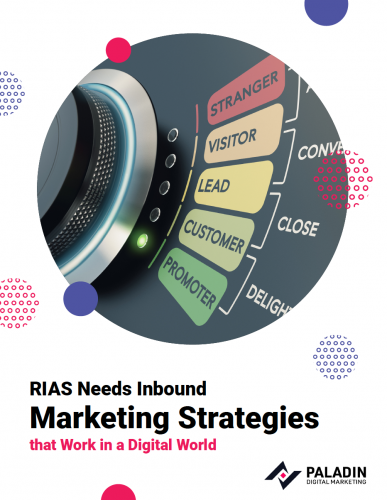Digital Marketing Guide For Financial Advisors
 Digital marketing is the future of the financial service industry. Old outbound marketing tactics are largely obsolete. Fewer and fewer investors are going to respond to these out-of-date marketing tactics.
Digital marketing is the future of the financial service industry. Old outbound marketing tactics are largely obsolete. Fewer and fewer investors are going to respond to these out-of-date marketing tactics.
What makes these tactics obsolete? Technology and the Internet have changed the game. For example, Caller-ID and spam filters limit who gets through to investors.
The more compelling reason is the Internet. It gives investors unprecedented access to information about financial advisors. They can use the Internet to find, research, and contact the advisors of their choice. They are no longer limited to the advisors who contact them – one more reason outbound marketing is destined for history’s dustbin.
Consequently, digital marketing will be even more prevalent in the future as increasing numbers of investors get more comfortable using the Internet to find and research financial advisors.
Perhaps virtual/digital is a new normal for the marketing and delivery of financial advice and services to investors. The need to jump in a car to drive to a meeting with a doctor, financial advisor, or CPA is rapidly receding in the rearview mirror.
The Internet is the delivery system that makes digital marketing possible. Investors can use the Internet to:
- Find financial advisors
- Research financial advisors
- Initiate contact with financial advisors
- Monitor financial advisors
Learn more in our blog articles:
How the Best Financial Advisors Control Their Presence on the Internet
How to Monitor Your Financial Advisor Reputation Management
Why Digital Marketing is Your Best Bet for Scaling Your RIA in 2021
What is Digital Marketing For Financial Advisors
 Harnessing the power of the Internet in a way that produces new clients for financial advisors is not rocket science. But it is a lot of hard work given the competitive nature of the marketplace.
Harnessing the power of the Internet in a way that produces new clients for financial advisors is not rocket science. But it is a lot of hard work given the competitive nature of the marketplace.
Everyone knows they are competing for a finite amount of space on page one of the major search engines. Why page one? According to Google, 91.5% of its users do not scroll to page two, only 4.8% make it to page two, and only 1.1% to page three. This means page one visibility is almost 20 times more valuable than page 2. And, the risk on page 2 is no one will scroll to see your content or advertising.
Digital marketing, when it is referred to as SEO (Search Engine Optimization), is the process financial advisors use to achieve page rank visibility for keywords that drive the right types of traffic to their websites.
Digital marketing also extends to financial advisor websites. They have the critical role of converting traffic/visitors into qualified prospects.
Read our blog articles:
How Digital Marketing is the Key to Higher Financial Advisor Website Page Ranks
How Financial Advisors Can Rank Higher on Google
Digital Marketing Helps Financial Advisors Create More Credibility, Trust, and Leads
Why Does Digital Marketing Level the Playing Field?
The biggest and smallest firms in the financial services industry have websites. Big firms tend to load their websites with information that undermines the productivity of their websites. On the other hand, smaller firms tend to be more focused when they limit website content to the information that investors really want to see.
This phenomenon is also impacted by the amount of time investors spend on financial advisor websites. Let’s assume their average time on site is three minutes. What messaging and information should financial advisors deliver in that time frame? Since “need to know” varies by the investor, it stands to reason bigger and smaller firms should identify the most important information and use intuitive navigation to deliver it.
The greatest impact of firm size may be the ability of bigger firms to spend more digital marketing dollars on Internet visibility and traffic. But, even then smaller firms may have the advantage of being more focused on particular market segments.
The search engines reward firms that are more specialized.

Learn How Financial Advisors Maximize Their Digital Marketing Results
and the Top 3 Ways Financial Advisors Use Digital Marketing to Turn Leads Into Clients
Why Does Digital Marketing Matter?
If investors are going to use the Internet to find and research financial advisors it stands to reason the advisors should make that process as easy as possible for them.
Therein lies the value of digital marketing. It is the process that financial advisors use to boost their online visibility and generate traffic for their websites. In the absence of digital marketing, financial advisors are relatively invisible on the Internet. They are missing a major business opportunity to reach investors who are seeking advisors and information.
It is very difficult to grow businesses when their ideal clients do not know they exist.

Learn How Digital Marketing Helps Financial Advisors During the COVID-19 Pandemic
and why Digital Marketing For Breakaway Financial Advisors Is No Longer An Optional Strategy
How Does Digital Marketing Work?

Digital marketing starts with the design and development of a lead generation website. Why spend money on inbound marketing if the financial advisors’ websites cannot convert traffic into qualified leads?
Once a website is converting, the financial advisors’ attention shifts to producing traffic for the website. A lot of professionals refer to this process as inbound marketing. The key to this type of marketing is the Internet. It enables investors to find and research financial advisors. And, most importantly investors initiate contact with financial advisors. This is the opposite of obsolete outbound marketing tactics that financial advisors used for decades. In the outbound world, the advisors had to initiate contact with investors - even when they did not want the contact.
So, in a nutshell, digital marketing is a combination of Inbound marketing tactics that advisors use to produce Internet visibility, website traffic, and websites that can convert the traffic into qualified prospects.
Read our blog articles:
How to Generate More Leads on Financial Advisor Websites
Top 5 Questions Financial Advisors Should Ask About Digital Marketing
SEO Versus SEM
Google uses a complex algorithm to rank financial advisor content and websites in its search engine. There are two ways to achieve this ranking.
SEO (Search Engine Optimization) is the most popular because even though it takes more time, it is definitely more affordable and lasts longer. SEM (Search Engine Marketing) is faster if financial advisors have deep pockets that will support page one advertising campaigns. However, most of this space is dominated by brand names with big marketing budgets. This is good for Google and the brand names, but bad for smaller firms who cannot afford to compete for this limited amount of space.
The process of SEO is building a solid foundation (Internet visibility) in the major search engines using content marketing (blog articles, pillar pages), social media marketing, Local SEO marketing, and drip email campaigns.
Some financial advisors use SEO and SEM to accelerate the growth of their firms.
Read our blog articles:
Top 10 Reasons Why Financial Advisors Should Send Monthly Newsletters to Clients and Prospects
Websites for Financial Advisors
Without a doubt, a financial advisor’s single most valuable marketing tool is a website that is capable of converting visitors into qualified prospects.
Great Internet visibility and website traffic will produce little or no results if a financial advisor’s website cannot convert the traffic into qualified prospects.
It is common knowledge that financial advisor websites are a delivery system for information about the firm and the professionals who work there. This is why a high percentage of advisor websites are online sales brochures that are designed to deliver this information. However, they are not designed to convert visitors into qualified leads, which is a problem for the majority of financial advisor websites.

What Is the Most Important Page on a Financial Advisor Website?
There is a different type of website that gives visitors several reasons to initiate the engagement process. The sites have to make the right offers and provide a process that makes investors feel safe when they submit their contact information.
Learn more in our blog articles:
Make the Best Financial Advisor Video in 5 Easy Steps
Is My Custom Financial Advisor Website a Fake?
Financial Advisors: What Is Your Digital Marketing Strategy For 2022?
The Importance of Digital Marketing
American businesses spend billions of dollars per year on digital marketing services for one simple reason. Regardless of your service or product, people have to know you exist in order to contact you. That is why financial advisors use digital marketing to create the Internet visibility they need to be found and contacted.
A simple illustration of this principle is the retail store in a mall versus the store in a stand-alone building outside the mall. The mall makes it easy for consumers to find the retail merchant, which is why companies pay big premiums to be located in malls. Retailers outside the mall are less visible, therefore they have less traffic and lower revenues.
Now transition that same merchant to the Internet. How do consumers find the merchant when there are thousands of competing entities? They use digital marketing to build an online footprint that makes them visible. This is the equivalent of spending big money for space in the mall. It is all about visibility that produces the traffic all businesses need to be successful.

Check out our Financial Advisor Digital Marketing SEO Plan for 2021
Persona-Based Marketing
Every financial advisor wants a steady flow of visitors on their websites. This is no different than retail mall merchants wanting a steady flow of shoppers coming through the front doors of their stores.
However, in the case of financial advisors, they do not want just anyone walking through their doors or visiting their websites. They want the right types of people visiting their websites and offices.
In this case, digital marketing actually facilitates persona-based marketing. For example, a financial advisor prefers to work with pre-retirees who have at least $500,000 available for investment. This advisor is not interested in reaching millennials who are just getting started in their careers.
The more specialized the financial advisor, the easier it is to market them on the Internet.
Blogs for Financial Advisors
Some advisors download content from libraries to make their blog sites look more robust. This type of content has absolutely no SEO value because Google has already seen it.
Google will give you SEO value for content that people actually open and read. Just like there are no Google SEO credits for duplicate content, there are no credits for content that is not open and read by investors. Google creates value when it connects users to high-quality content they actually open and read.
Read our blog articles:
Don’t Forget Pillar Pages
Whereas articles are published on financial advisor blog sites, pillar pages are published on financial advisor websites.
Pillar pages are another Google convention that establishes a financial advisor’s authority for a particular topic. The articles on a financial blog site are linked through the pillar pages.
The pillar page says your firm is an expert on particular financial, investment, tax, or legal topics. This is what Google is looking for - experts on financial topics that benefit Google users.
Advisors who want to optimize their visibility in Google must produce a consistent flow of new articles and pillar pages. Hundreds of articles can be connected through pillar pages.
Social Media for Financial Advisors
 Social media is not just a few posts per month on one channel. It is a focused, consistent effort to build your online visibility on multiple channels: Facebook, LinkedIn, and Twitter.
Social media is not just a few posts per month on one channel. It is a focused, consistent effort to build your online visibility on multiple channels: Facebook, LinkedIn, and Twitter.
Social media is a blend of market research, high-quality blog articles, posts, and the development of reciprocal relationships with relevant influencers, users, and followers.
In its most basic form, social media is a way to expand the visibility of financial advisor content that appears on their blog sites.
Increased visibility is the primary goal of digital marketing.
Read our blog articles:
Top Social Media Post Ideas for Financial Advisors
How Financial Advisors are Using Video on Social Media
Financial Advisor Social Media: Twitter Versus Facebook
When is the Best Time for Financial Advisors to Post on Facebook?
Financial Advisor Social Media: Best Time to Post on Twitter
CRM for Financial Advisors
Not everyone has an immediate need for a financial advisor. In fact, most people do not have quick needs for advisors. They are seeking information today and financial advisors tomorrow.
The problem is advisors want investors with immediate needs so they can quickly convert them into clients and income for themselves - now not later. So, they put very little value on contacts who may have future needs. Unfortunately, what financial advisors want is secondary. Investors finding what they are looking for is what matters most to them. And what matters most may be gathering information about advisors before they start their interview processes.
It pays for all financial advisors to subscribe to a robust CRM system that tracks the nurturing of investors from the lead stage to the revenue-producing client stage.
Learn more in our blog articles:
Top 8 Reasons Why Hubspot is the Best CRM for Financial Advisors
How Financial Advisors Use Hubspot Workflows to Convert Leads into Clients
Free Offers for Financial Advisors
A high-quality free offer has one purpose - convince investors to engage with financial advisors. This makes the free offer an important part of financial advisors’ digital marketing strategy.
One of the best examples of a free offer is an eBook on financial advisor websites or as part of an advisor’s advertising campaign. Rather than just ask investors to submit their contact information in ads or on websites, financial advisors should offer them something of value in exchange for their contact information.
From a strategic perspective, this means the free offer must be good enough that investors will give-up their anonymity and register to get it. Therefore, the best free offers solve financial problems that are experienced by advisors’ ideal types of clients.
Webinars for Financial Advisors
Financial advisor webinars are another example of free offers that require registration for attendance. The same principles apply to webinars that apply to eBooks. They must be of sufficient quality that investors will register to attend the webinars.
That said, webinars also have some challenges that eBooks don’t have. Instead of just writing eBooks financial advisors have to produce webinars (script, enhance, record) and generate the attendance. So, not only do investors have to give-up their anonymity, they have to commit time to attend the webinars (live or on-demand). This puts even more pressure on financial advisors to produce great webinars.
Then advisors need strategies for promoting webinars that produce attendees. And, once investors attend webinars, the content has to be good enough that investors view the complete webinar. There is nothing worse than attendees dropping off after the first five minutes.
CTAs for Financial Advisors
Digital marketing takes a sophisticated strategy and work, but it is not brain surgery. Financial advisors need Internet visibility, traffic, and conversions to be successful. A conversion occurs when investors submit their contact information.
Regardless of the digital marketing strategy that financial advisors use to produce leads, there are a few fundamentals that facilitate this process. For example, websites and paid ads should have Calls to Action (CTAs) that compel investors to initiate contact. For example, a paid ad contains an offer and a CTA that takes investors to landing pages that capture their contact information.
High-quality CTAs encourage investors to take action in a safe environment.
Paid Advertising for Financial Advisors
SEO (Search Engine Optimization) is a process that builds financial advisor visibility on the Internet. In a nutshell, this means advisors have to rank on page one for keywords that drive the right types of clients to their websites. This is a process that takes time. How much time? That depends on the financial advisors’ marketing budgets.
In some cases, a better use of that marketing budget could be paid advertising. This process is referred to as SEM (Search Engine Marketing). Instead of earning visibility over time using SEO, financial advisors can buy it using SEM and be on page one of the major search engines the next day.
All it takes is money and an offer that motivates investors to respond.
Read our blog article: Does Your Financial Advisor Firm Need a Pay Per Click Service?
Updated 9/15/2021

We've Made Digital Marketing Easy for Financial Advisors
Our free, no-obligation eBook makes understanding digital marketing strategies easy.
Download Now



